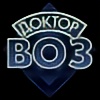HOME | DD
 KatesFriend — EGO 0602-00911069602
KatesFriend — EGO 0602-00911069602

#alien #biosphere #moon #space #volcanic #habitat #planet #volcano
Published: 2019-08-10 17:25:49 +0000 UTC; Views: 520; Favourites: 5; Downloads: 0
Redirect to original
Description
ENCYCLOPEDIA GALACTICA Edition 428193 - Earth EnglishEGO 0602-00911069602: Summary
EGO 0602- 00911069602 is the second satellite of EGO 0602-00911069544 - a fourteen (14) Jovian mass 'Y' or 'brown' dwarf informally named 'Freya' - and first life bearing world of 'Freya's Necklace'.1 This world differs from others in the 'necklace' with the incorporation of silicon (Si) within the local biochemistry. The biosphere is also thermoconsumptive and largely subsurface.2 That, extensive volcanism, lack of atmosphere and no near surface liquids initially left the moon overlooked as a life bearing world. Nevertheless, it is now known to be the oldest life bearing body in the system by as much as four (4) hundred million (108) years.3 The moon has no recognized common name.4
Si lifeforms are hard to recognize and difficult to study. Simplest forms are mistaken as low grade mineral seams. Their requisite robustness results in low biodiversity. And Si life is both heavy and fragile compared to carbon (C) life. Only after long observation of the habitat do bio-indicators become recognizable. In the case of EGO 0602-00911069602, the weight impediment is marginalized by the moon's small mass - low gravity. A factor which likely contributed to its swifter formation. In retrospect, signs of life are observable on the surface but were mistaken for exotic planetary chemistry. “Surface life” congregate close to volcanoes for the energy and raw materials provided from below.
The moon is a terrestrial object with a mass of 0.029 Earths.5 Other characteristics include:
- Diameter: 2453 km
- Density: 2.8 g/cm3
- Rotational Period: 17371 sec (0.20 days, captured)6
- Axial Tilt: 2.2°
- Orbital Eccentricity: 0.06
- Orbital Inclination: 1.9°
- Orbital Period: 17371 sec (0.20 days)
- Orbital Radius: 242.2 thousand (103) km
Life is concentrated one (1) to four (4) kilometres (10^3m) above the crust-mantle boundary – thirty-eight (38) to fifty-six (56) km below the surface. These depths are hot enough (1700 to 1900°C) for silicates, carbonates and other materials to intermix in the three classic physical states. And they are too hot and toxic for purely C based biochemistry. But the stronger crystalline bonds of Si withstand such conditions.
Genetics are encoded within dual interlaced silicon-carbide (Si:C) crystals.7 “Etched” within the Si lattice are C atom chains. Chain C atoms link to neighbouring C and Si atoms using single or double bonds. There are also 'null bonds' - broken C-Si bonds - with respect to the C atoms. On a C atom, a double bond can be associated with a Si atom or a neighbouring chain C atom, thus a C atom may be in one of seven (7) states in a chain.
As C atoms are limited to four chemical bonds, the states can be classified in terms of permissible neighbours.
- Class W: State 4
- Class X: States 1, 2, 3
- Class Y: States 5, 6
- Class Z: State 7
Wherein the following class pairings are permitted.
- W=X
- X=W
- X=Y
- Y=X
- Y=Z
- Z=Y
In concept, akin to nucleotide pairing within terrestrial DNA.8 However, more simplistic which, combined with its robustness, slows mutative change. Biodiversity is less than fifty-six (56) thousand (103) detected species.
Not surprisingly there is no evidence of a technical society on EGO 0602-00911069602. Nevertheless, there is confirmed evidence of social and even cooperative behavior amongst some of the few observed species – 184 at last count - which dwell near the surface.
Notes: EGO: Encyclopedia Galactica Object
See References:
1Definition: 'Freya's Necklace'
2Definition: 'Thermoconsumptive Ecology'
3Civilization Humanity: Scientific Standards
4Civilization Humanity: Naming Conventions For Astronomical Objects
5Definition: 'Terrestrial Planet'
6Definition: 'Captured Rotation'
7Crystalline Heredity Encoding: Advantages and Disadvantages
8Definition: 'DNA'

















